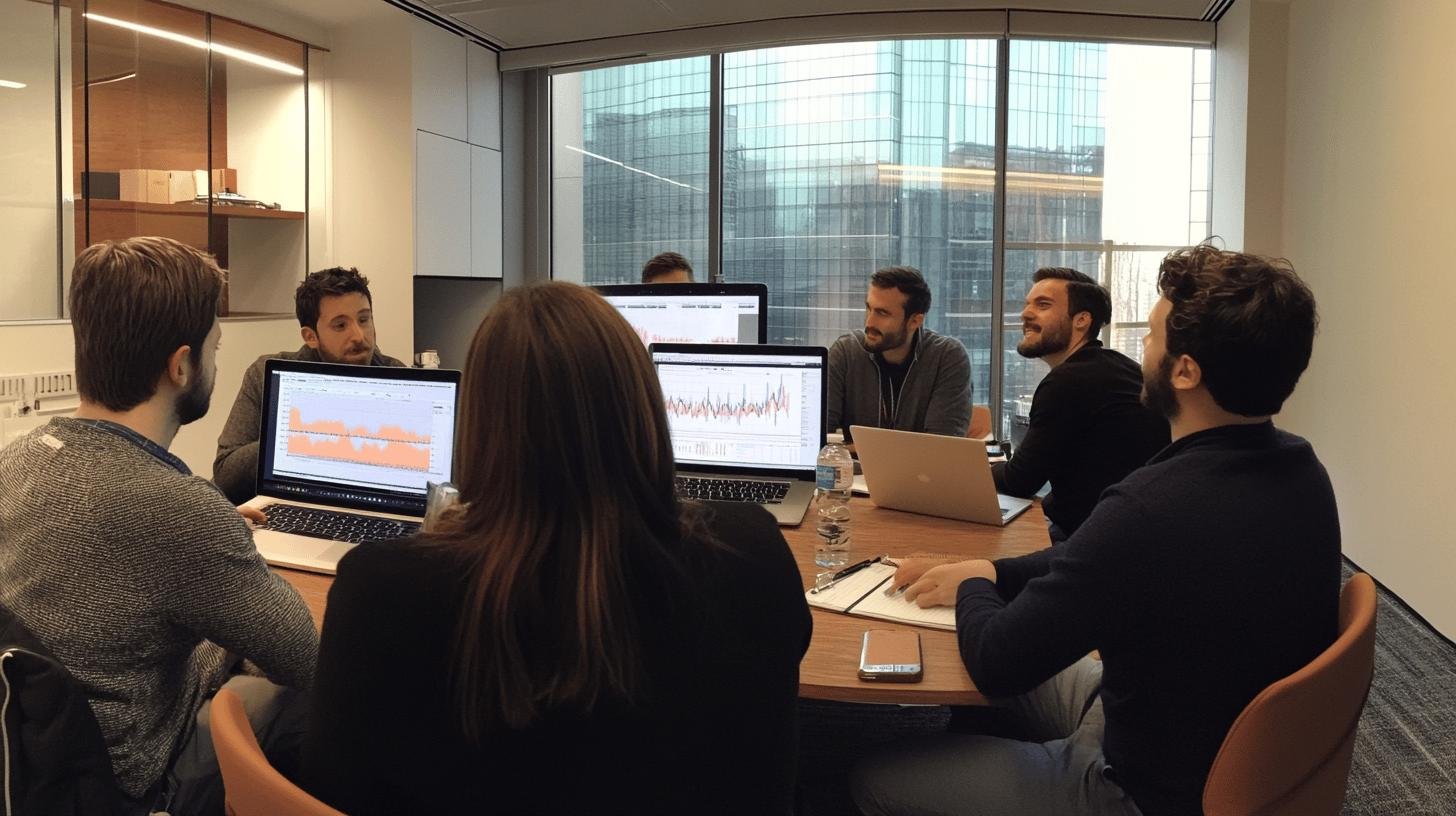Do you ever feel like your business decisions are a shot in the dark? 🎯 Imagine having a crystal ball to see the impact of every move you make. That’s what data analytics and reporting offer! By diving into raw data and presenting it clearly, these tools empower you to make informed choices. 📊
Whether you’re analyzing last quarter’s sales dip or forecasting next month’s performance, understanding data analytics and reporting is your secret weapon. Ready to geek out? Let’s dive in! 🚀
Understanding Data Analytics and Reporting
Data analytics is like being a detective for numbers. 🕵️♂️ It involves examining raw data to find patterns, trends, and insights. Imagine a big pile of information and wanting to discover what it means and predict future events. That’s data analytics! It’s crucial for businesses as it helps make smart decisions based on facts, not just guesses.
Data reporting, however, is about organizing and presenting data in an easy-to-understand way. Think of it as a report card from school. 📊 It shows your grades for each subject, making your performance clear. Data reporting works similarly but for businesses. It focuses on specific metrics and key performance indicators (KPIs), like sales numbers or customer satisfaction scores, to show current performance.
Together, data analytics and reporting are essential for making informed business decisions. Analytics provides actionable insights, helping businesses know what to do next. Reporting gives a snapshot of the current status. Combined, they help businesses stay on track and plan for the future.
5 Key Metrics in Data Reporting
- Sales Revenue: Total money earned from sales.
- Customer Acquisition Cost (CAC): Cost to acquire a new customer.
- Customer Lifetime Value (CLV): Total value a customer brings throughout their relationship.
- Net Promoter Score (NPS): Measures customer satisfaction and loyalty.
- Conversion Rate: Percentage of visitors who complete a desired action, like making a purchase.
Types of Data Analytics

Descriptive Analytics
Descriptive analytics is like looking in the rearview mirror. It summarizes past data to give a clear picture of what has happened. Imagine running a lemonade stand all summer and tracking daily sales. At the end of summer, you review the sales to find patterns, like which days had the highest sales. That’s descriptive analytics! Businesses use it to understand historical performance and identify trends.
Diagnostic Analytics
Diagnostic analytics is like playing detective. It digs into data to determine why something happened. For example, if lemonade sales dropped one weekend, diagnostic analytics would look at weather, competing events, or recipe changes to find the cause. In business, it helps identify reasons behind trends and anomalies, making it easier to address issues and improve performance.
Predictive Analytics
Predictive analytics is like having a crystal ball. It uses historical data to forecast future events. For instance, if lemonade sales increased every time the temperature hit 90 degrees, you could predict that sales would rise again the next time it gets that hot. Businesses use predictive analytics to make informed guesses about future trends, aiding in better planning and competition.
Prescriptive Analytics
Prescriptive analytics is like having a wise advisor. It not only predicts future events but also suggests actions based on data. Imagine you’re unsure how much lemonade to make for an upcoming event. Prescriptive analytics could recommend the optimal amount to prepare, minimizing waste and maximizing profits. Companies use this type for strategic planning and decision-making.
Tools for Data Analytics and Reporting
Having the right tools is a game-changer for making sense of data. 🛠️ Here are some of the best tools for data analytics and reporting.
Popular Data Analytics Tools
These tools are widely used and feature-rich:
- Tableau: Known for its user-friendly interface and powerful visualizations. Tableau helps you create impressive charts and dashboards that are easy to share.
- Power BI: Microsoft’s Power BI integrates well with other Microsoft products like Excel and offers robust data modeling and real-time analytics.
- Google Analytics: Ideal for understanding web traffic. It tracks everything from page views to user behavior, offering a complete picture of your online presence.
Free Data Reporting Tools
For those not ready to invest heavily, free tools offer substantial features:
- Google Data Studio: Allows you to create interactive dashboards and reports for free. Ideal for small businesses and startups.
- Apache Superset: An open-source tool with a wide range of data visualization options. Highly customizable for those who like tinkering.
- Metabase: Another open-source option, Metabase is user-friendly and doesn’t require you to be a data scientist to create insightful reports.
Advanced Analytics Tools
For advanced features, these tools stand out:
- SAS: Known for advanced analytics, SAS handles complex data modeling and statistical analysis. Widely used in industries like healthcare and finance.
- RapidMiner: Excels in machine learning and predictive analytics. Ideal for businesses looking to uncover hidden patterns in data.
- Alteryx: Simplifies data preparation, blending, and analysis. Useful for teams collaborating on complex data projects.
| Tool Name | Features |
|---|---|
| Tableau | User-friendly, powerful visualizations |
| Power BI | Integrates with Microsoft products, real-time analytics |
| Google Analytics | Tracks web traffic and user behavior |
| Google Data Studio | Free, interactive dashboards |
| SAS | Advanced analytics, complex data modeling |
| RapidMiner | Machine learning, predictive analytics |
Data Analytics in Business

Data analytics is a game-changer for businesses. It helps optimize operations, understand customer behavior, and make better decisions. Imagine running a store—data analytics can show which products sell well and which don’t. This allows you to adjust inventory and meet customer demands more effectively.
Several techniques are common in business analytics. One popular method is regression analysis, which examines the relationship between variables, like how advertising spend affects sales. Another is time series analysis, which is perfect for tracking trends over time, such as seasonal sales patterns.
Real-life examples of data analytics in action are everywhere. Predictive analytics helps companies forecast future sales based on historical data, aiding in inventory and staffing planning. Customer segmentation, which groups customers by buying behavior, preferences, or demographics, enables targeted marketing campaigns and personalized experiences.
3 Business Analytics Techniques
- Regression Analysis: Examines relationships between variables to identify trends.
- Time Series Analysis: Studies data points over time to track trends.
- Predictive Analytics: Uses historical data to forecast future trends.
Reporting vs. Analytics: Differences and Similarities
Reporting and analytics sound similar but serve different purposes. Reporting creates a snapshot of current performance, organizing data into a readable format focused on specific metrics and KPIs. Think of it as a report card for business performance. Analytics, however, digs deeper into the data to provide insights, find patterns, and predict future trends. While reports tell you the “what,” analytics helps you understand the “why” and “how.”
Key differences include the nature of reports and analytics. Reports are static, presenting data as it is. For example, a report might show last month’s sales figures. Analytics, however, is dynamic, analyzing data to offer actionable insights. If a report shows a dip in sales, analytics helps figure out why that dip happened and suggests fixes. Essentially, reports provide information, while analytics offers solutions.
Despite their differences, reporting and analytics complement each other in data strategies. Reporting provides a clear picture of the current status, essential for identifying improvement areas. Analytics uses this information to dive deeper, offering recommendations and predictions. Together, they help businesses make informed decisions and plan effectively.
4 Key Roles and Skills in Data Reporting
- Data Analyst: Skilled in data collection and basic analysis.
- Report Developer: Proficient in creating detailed reports and dashboards.
- Data Quality Specialist: Ensures the accuracy and reliability of data.
- Business Intelligence (BI) Analyst: Combines business knowledge with data expertise to generate insights.
Best Practices for Data Analytics and Reporting

Following best practices in data analytics and reporting is key to success. First, define clear goals. Know what you want to achieve with your data to choose the right tools and align efforts with business objectives. Using the right tools helps collect, analyze, and visualize data efficiently. Ensuring data quality is crucial—clean, accurate data forms the foundation of reliable analytics.
Effective data collection methods are vital. Choose the right data sources to ensure relevance and reliability. Use automated tools to collect data in real-time, minimizing errors and saving time. Regularly audit your data for accuracy and completeness, ensuring trust in your insights.
Visualization techniques make complex data easy to understand. Use charts and graphs for visual appeal. For instance, bar charts are great for comparing categories, while line graphs are perfect for showing trends over time. Dashboards combine multiple visualizations for a comprehensive data view. Effective visualization aids quick decision-making and helps communicate insights clearly to stakeholders.
5 Best Practices for Data Analytics and Reporting
- Define clear goals.
- Use the right tools.
- Ensure data quality.
- Choose effective data collection methods.
- Utilize visualization techniques like charts and graphs.
Final Words
We explored data analytics and reporting, breaking down their importance and how they help in decision-making. From different types of analytics like descriptive, diagnostic, predictive, and prescriptive to tools like Tableau and Google Data Studio—each has its role. Businesses are leveraging these to optimize operations and better understand customers, using techniques like regression analysis. Remember, reporting organizes data, while analytics offers actionable insights. Following best practices ensures quality results. Dive deeper into the world of data with WikiWayne and stay ahead in your business game! 🎉
FAQs
What does a data and reporting analyst do?
A data and reporting analyst examines data and prepares reports to help organizations make informed decisions. They gather data, analyze trends, and present findings in clear reports using visual aids like charts.
Is data analytics a good career?
Yes, data analytics is a great career with high demand and good salaries. It’s suited for those who enjoy problem-solving and have strong analytical skills.
What are the 5 data analytics?
The five types of data analytics are:
- Descriptive Analytics: Summarizes past data.
- Diagnostic Analytics: Analyzes reasons behind data.
- Predictive Analytics: Forecasts future trends.
- Prescriptive Analytics: Recommends actions.
- Cognitive Analytics: Mimics human decision-making using AI.
Why is data analysis and reporting important?
Data analysis and reporting help businesses make decisions based on facts. They provide insights into trends, improve efficiency, and help identify opportunities and risks.
How can small businesses benefit from data analytics and reporting?
Small businesses can use data analytics and reporting to understand customer behavior, optimize marketing, and improve efficiency. Even basic tools like Google Analytics can help them identify popular products and make data-driven decisions to boost profitability.




